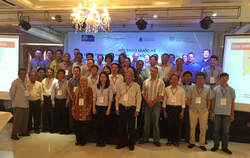 By Pham Luong, HELVETAS Swiss Intercooperation Published in January 2016, on ACIAR in Vietnam’s newsletter From 30 November to 3 December 2015, an international workshop on Beef Markets and Trade in China and Southeast Asia was organised in Ben Tre province in Southern Vietnam to identify strategic constraints and opportunities for research, development and collaboration that will enhance development of inclusive and sustainable beef industries, markets and trade in China and Southeast Asia. The workshop was funded by ACIAR and co-organised by HELVETAS Vietnam, the University of Queensland and the People’s Committee of Ben Tre province. International experts and policymakers attending the regional workshop on beef markets and trade in Ben Tre province, Vietnam The workshop attracted the participation of a large number of stakeholders from different countries including China, Vietnam, Cambodia, Laos, Myanmar, Thailand, Indonesia and Timor-Leste, and also several Australian agencies including ACIAR, Department of Agriculture and Water Resources, Austrade, Meat & Livestock Australia, state government representatives from Queensland, Northern Territory, Western Australia, and ACIAR project participants and other beef industry experts and consultants. The reports of crosscutting themes from country sessions suggested that beef markets and trade in China and Southeast Asia have undergone major change in ways that could not have been envisioned only a decade ago. Unprecedented economic growth and urbanisation has increased beef consumption in parts of the region. For example, between 2000 and 2013, average annual beef consumption increased by 8% in Vietnam and around 4% in China, while beef prices increased by 8% and 11% respectively. The increases in consumption have not, however, seen a parallel response in cattle numbers. Over the same period, the cattle herd in China and Southeast Asia decreased (especially in China, which makes up 69% of cattle numbers) for several reasons including increasing opportunity costs of labour in countries that experienced broad-based growth; large scale farm mechanisation that have reduced the need for draught cattle; and farmers selling cattle to take advantage of high prices. In a regional cattle industry dominated by smallholders, the supply response to rising prices has been muted – especially for cow-calf production – compared to other more commercialised livestock industries including pigs and chickens. These supply–demand settings have generated several significant trends. While cattle numbers have stagnated (-0.3%), turnoff numbers and beef production have increased (1.9% and 2.5% respectively), indicating higher turnoff rates and increased carcass weights as proxies for gradual industry productivity. While regional beef industries are dominated by smallholders and individual household actors, there has been several hotspots of industry growth – especially in the feedlot sector and other downstream sectors. Most importantly, there has been a major increase in the trade of cattle and beef. The volume of beef officially imported into China, Vietnam and Indonesia increased from approximately 100,000 tonnes in 2008 to 430,000 tonnes in 2013. Another one million tonnes entered China from India, Brazil and the US through informal channels in 2014. These countries formally imported more than 900,000 cattle, while about 300,000 more, mainly from Myanmar, crossed into China and traversed Thailand, Laos, Cambodia and then entered Vietnam through a myriad of established and opportunistic trade routes. The experts agreed that these evolving market and trade settings have major implications for disease and bio-security risks associated with livestock trading, consumer access to red meat protein, food price inflation, and rural development. At the same time, regional market and trade development patterns have a direct, but largely unknown or unquantified, effect on markets for Australian cattle and/or beef. The participants of the workshop also discussed and identified key gaps and challenges in the areas of smallholder involvement in the industry, regional integration and cooperation, biosecurity and accuracy of data and statistics. These will shape ideas and activities of future projects, as well as the short and long-term priorities of these countries. For further information, please contact Dr Pham Luong at [email protected]rg
0 Comments
Your comment will be posted after it is approved.
Leave a Reply. |
AuthorArchived posts from the “Review of Regional Beef Market and Trade in China and Southeast Asia”, project 2015-2017 funded by ACIAR and jointly implemented by the University of Queensland and HELVETAS Swiss Intercooperation Vietnam Archives |

 RSS Feed
RSS Feed





